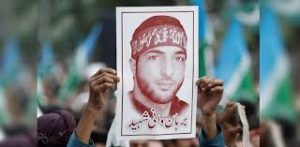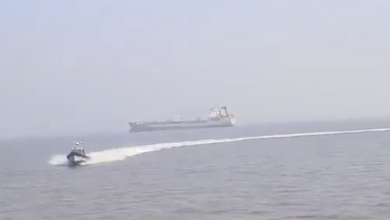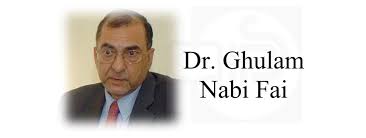The Legacy of Burhan Wani: Catalyst for Kashmir’s Freedom Struggle
 Burhan Muzaffar Wani, a name of the revolution, a face of resilience and a symbol of resistance continues to live on in every Kashmiri heart, his legacy stands as the unyielding spirit of defiance against oppression and a beacon of hope for a future free from strife.
Burhan Muzaffar Wani, a name of the revolution, a face of resilience and a symbol of resistance continues to live on in every Kashmiri heart, his legacy stands as the unyielding spirit of defiance against oppression and a beacon of hope for a future free from strife.
Burhan’s martyrdom anniversary highlights the ceaseless struggle in Indian occupied Jammu and Kashmir. Wani, a commander of Hizbul Mujahideen (HuM), became an emblematic figure of the Kashmiri freedom movement. He symbolized the new wave of youthful defiance against Indian rule. His martyrdom on July 8, 2016, marked a significant turning point in the ongoing conflict which exposed the depth of the region’s socio-political dynamics. The aftermath saw a resurgence of protests, a heavy-handed response from Indian occupation forces and an escalation in human rights abuses, all profoundly impacting regional stability and international relations.
Born on September 19, 1994, in Dadsara village of Tral, Pulwama, Burhan Wani was the son of a school principal and a Quran teacher. Despite his promising academic trajectory, the personal trauma inflicted by Indian occupation forces pushed Wani into resistance movement. In 2010, at the age of 16, an incident involving the brutal beating of his elder brother Khalid by Indian soldiers catalysed Wani’s decision to join HuM. Six months later, Wani left home and never returned, dedicating his life to the armed struggle against Indian occupation.
Wani’s adept use of social media platforms like Facebook and WhatsApp distinguished him from earlier generations of freedom fighters. He openly revealed his identity, encouraging young Kashmiris to join the resistance movement. His charismatic appeal and strategic communication turned him into a household name. This boosted the Kashmiri freedom narrative and garnered widespread support among the youth. This digital activism invigorated the movement, countering the Indian state’s attempts to suppress dissent through traditional and social media blackouts.
Burhan Wani’s killing on July 8, 2016, by Indian forces in Bundoora village of Kokernag marked a pivotal moment in the Kashmir conflict. The immediate aftermath saw massive protests, with an estimated 200,000 people attending his funeral. The use of force by Indian troops during these protests resulted in significant casualties, with over 60 people killed and around 5,500 injured. The unrest following Wani’s death surpassed previous episodes of resistance, underscoring the deep-seated discontent among Kashmiris.
The response to Wani’s martyrdom exposed the harsh realities of Indian draconian laws for instance the Armed Forces Special Powers Act (AFSPA). Human rights violations, including custodial killings, mass arrests and the use of pellet guns, have been well-documented. From January 1989 to June 2016, the conflict has led to the deaths of 94,391 individuals, with thousands of others suffering from the fallout of the prolonged military presence.
Internationally, Wani’s death and the subsequent human rights abuses drew attention from bodies like the European Union and the United Nations. The EU expressed concerns over civilian casualties and urged for dialogue involving Kashmiris. The U.S. State Department also called for a peaceful resolution, highlighting the need for India and Pakistan to address the grievances of the Kashmiri people.
The scale and intensity of these protests demonstrated the transformation of the freedom struggle from a largely freedom movement to a mass civilian uprising. The widespread participation of civilians, including women and children, underscored the collective resolve of the Kashmiri people.
Wani’s martyrdom marked a shift in the dynamics of Kashmir’s freedom struggle in several key ways: First, the large-scale participation in protests indicated a broadening of the resistance movement. No longer confined to freedom fighters’ groups, the struggle now included ordinary citizens demanding their rights. Second, Wani’s death also led to a surge in local youth joining resistance movement. There was a significant increase in the number of local recruits in resistance movements following 2016. Third, the global media coverage of the protests and the subsequent human rights abuses brought international attention to the Kashmir issue. Reports by organizations such as Amnesty International and Human Rights Watch highlighted the excessive use of force by Indian occupation forces.
In response to the unrest, the Indian government implemented a series of measures aimed at projecting an image of normalcy in Kashmir. The government imposed curfews, suspended internet and mobile services and banned local newspapers. These measures were intended to curb the flow of information and prevent the coordination of protests. However, they also drew criticism from international bodies concerned about freedom of expression and the right to information. The local administration, under Chief Minister Mehbooba Mufti, attempted to downplay the unrest. Efforts were made to show that the government was in control, including the dredging of Dal Lake and the hurried beautification of Srinagar ahead of the Durbar Move in May 2016. These actions were criticized as superficial attempts to mask the underlying discontent. The heavy deployment of occupation forces in the Valley was justified by the Indian government as necessary for maintaining law and order. However, the pervasive military presence contributed to a climate of fear and repression among the local population. The Armed Forces Special Powers Act (AFSPA), Public Safety Act (PSA) and nlawful Activities (Prevention) Act (UAPA) provided legal immunity to Indian forces, enabling human rights abuses without accountability. The Indian government announced various economic packages and development projects aimed at winning hearts and minds. However, these initiatives were often seen as attempts to buy peace rather than address the root causes of the conflict.
The legacy of Burhan Wani continues to resonate in the Kashmiri freedom struggle. His transformation from a bright student to a resistance leader underscores the tragic consequences of state oppression. Wani’s life and death have galvanized a new generation of Kashmiris, determined to seek justice and self-determination.
 By Mehr ur Nisa Director Research Kashmir institute of International Relations
By Mehr ur Nisa Director Research Kashmir institute of International Relations








